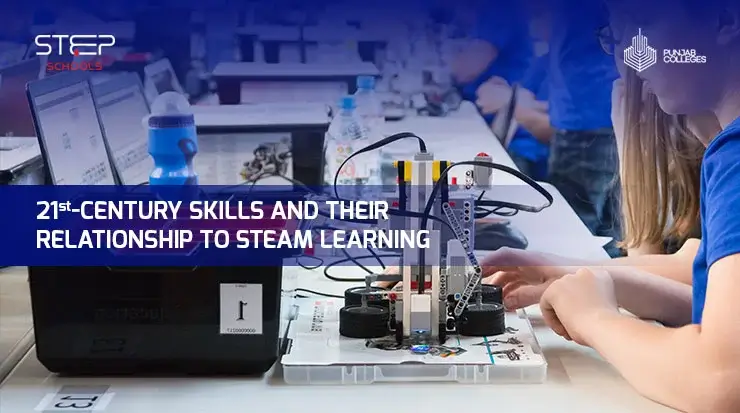STEAM Learning is essential for students to get ready for 21st-century challenges. Twenty-first-century skills include various educational and real-life skills. Collectively, the skills of the 21st century are divided into four parts. The skills are 12 in number. We have listed them below. Further, we have seen how STEAM learning helps children to develop 21st-century skills in them.
21st Century Skills
The skills of the 21st century are collected as twelve skills, majorly distributed as follows.
- Learning Skills
- Literacy Skills
- Life Skills
Learning skills include the skills like critical thinking, creativity, collaboration, and communication. Literacy skills include information, media and technological awareness, and life skills comprise of flexibility, leadership, productivity, social skills, and the power to initiate.
Explanation of Steam Learning
A teaching and learning strategy known as STEAM Education uses math, science, technology, engineering, and the arts to direct student inquiry, discussion, and problem-solving. According to education experts, acquiring practical skills is only one aspect of STEAM education. Additionally, it fosters in children the ability to:
- Take calculated risks.
- Take part in worthwhile learning activities.
- Grow to be resourceful problem-solvers.
- Accept and value cooperation.
- Exercise your creative faculties.
Benefits of Steam Learning in 21st-Century Education
Steam Learning help students think out of the box and find solutions that peruse them to think and act. This eventually helps students to be efficient with society, studies, and careers side-by-side.
- Students develop the skills of creative thinking,
- Active participation and performing out-of-the-box.
- Generate and express original ideas
- Takes hands-on experience in various things
- The students learn teamwork
- Learn Better Communication
- ICT (Information and Communications Technologies) literacy
- Adaptability
How steam education helps to develop the 21-st century skills
Career Development
The goal of the educational system is to prepare students for the workforce of the future. This justifies the significance of STEAM education. Students investigate via play, curiosity, and practical learning. Who knows, though? What they discover might pave the way for the upcoming STEAM career. The difficult aspect is that many STEAM careers are always changing. Even though we cannot forecast how employment will change, we can help children get the knowledge and skills they will need to succeed in those careers.
Community Services
Community involvement drives STEAM education at Step Schools. Everything is related to a community-related project or case study. To tackle actual issues and create practical solutions, students can choose from a variety of projects offered by community partners or based on their own interests—all while earning core academic credits.
Multi-visionary Skill Development
Being aware that STEAM is an interdisciplinary approach to education that draws on various facets of multiple academic disciplines to study a theme, issue, question, or topic is crucial.
According to research, an interdisciplinary approach to education helps students develop problem-solving skills by recognising bias, thinking critically, embracing ambiguity, and considering ethical issues. STEAM education uses an interdisciplinary approach, and both students and teachers are subject to it.
ICT Literacy Rate
The ability to read and write well is literacy. Digital literacy is among the skills that will be most valuable in the twenty-first century. Instead of accepting everything we hear, media literacy enables us to critically analyse media news and separate fact from fiction. Additionally, it helps us comprehend the information reported so that we are not duped (like the basics of scientific methods). Information literacy is assessing what information seems credible, what sounds exaggerated or made up, and the ability to explain why.
The significant sort of literacy is known as “tech literacy,” which refers to the ability to develop and collaborate with technology on a deeper level than merely absorbing it. Even when technology changes and advances, we can still programme it, build modern technology, and operate with it naturally. The best way to teach this kind of self-assurance and literacy is to learn to code, develop, modify, and alter technology to suit our needs.
Basics of Artificial Intelligence and Coding
Another 21st-century skill that needs our attention is coding. Robo Wunderkind and other STEAM gadgets are ideal for teaching kids these 21st-century abilities. They support inquiry, experimentation, creativity, critical and analytical thinking, teamwork, leadership, tech-savvy, and problem-solving skills. They are excellent companions for both the home and the classroom because of their versatility, and our frequent online challenges and webinars make it simple to always remain up to date with the latest STEM trends and connect with a vibrant community of budding students and zealous educators (whether professionals or parents).
Conclusion
It is high time to get an education in a way that engraves the skills of 21st-century education. STEAM learning is the appropriate and polished way out. Therefore, in Pakistan, you can avail the trend and education with STEAM learning leading to 21st-century skills at step schools.

